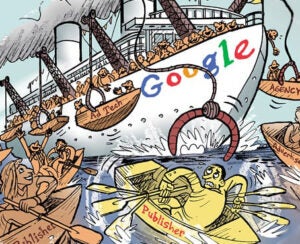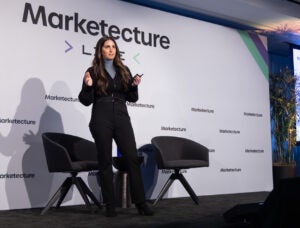 As an industry, data-driven marketing drives $156 billion in revenues and contributes 675,000 jobs to the US economy alone.
As an industry, data-driven marketing drives $156 billion in revenues and contributes 675,000 jobs to the US economy alone.
These figures, published and heralded onstage to thousands of marketers this morning by Direct Marketing Association president and CEO Linda Woolley, were part of a 100-page Data-Driven Marketing Economy report distributed today at the DMA 2013 Annual Conference and Exhibition in Chicago as part of the trade organization’s efforts to prove out the value of what it and its members do.
“California is the very state that is threatening to stop the collection and use of consumer data through a possible ballot initiative,” Woolley told reporters during a news conference immediately following her morning keynote. ” I really wanted to highlight the value of data in California. In California alone, 90,000 jobs come from the data-driven marketing economy and $21 billion was returned to the state of California in revenues.”
She went on, “We decided last year [at the annual DMA summit in Las Vegas] that research of this magnitude was critical. We really felt our industry was under siege between all of the investigations about privacy and data brokers. When we would go back to public policy decision makers, the question always posed to us was, ‘What are you doing here?’ ‘Why is this significant to the economy?’ but we didn’t really have the answers. If decision makers are considering further regulations, we really hope they will take this study in to consideration and not do anything that will stifle growth and innovation in this area.”
The study, conducted by Harvard Business School Professor John Deighton and Columbia Business School Professor Peter Johnson in conjunction with the DMA’s Data-Driven Marketing Institute, sought to quantify the effect of consumer data on the digital ecosystem from GDP standings to jobs. Deighton said the research process took a bottom-up approach that began with an evaluation of 3,500 companies that “get between the likes of a Coca-Cola and Chase Manhattan Bank and help them make contact with consumers at the other end of the sequence.”
From there, the research team whittled down its sample base to 650 companies, “talked to 10% and [iterated on] what we found in interviews [and supplemented what we could from] public sector data.” The study did not evaluate marketers but, rather, “all of the supplier firms helping producer [marketer] firms across any given media.”
Some of the “supplier” buckets in the breakdown included: audience assembly and targeting, such as SSPs and DSPs; agencies, like KBM Group and Merkle; the prospect and customer relationship manager, such as a Responsys or even the US postal service for direct mail distribution and commerce and fulfillment, such as loyalty players and call centers.
“A majority of data-driven marketing still happens in the offline world,” remarked Rachel Nyswander Thomas, executive director of the Data-Driven Marketing Institute. “Direct mail is the most developed and mature [form.] Marketing has been data-driven for a very long time. The history of offline can be a very good indicator of how we expect digital to develop in the online.”
According to the DDME report, 60% of the recorded revenues were driven by offline data while the remaining 40% represented the online. According to Deighton, 30% of revenues identified on the online side “happened within data-intensive organizations that don’t have to go outside their own boundaries,” companies like Google and Amazon that are building out first-party data fortresses directly with consumers.
When asked to elaborate on breakdowns of each data-driven marketing “bucket” as a contributor to overall industry revenue, Deighton told AdExchanger that “a great deal of data-driven marketing still occurs in the physical world.” But, “even as the most superficial views of marketing would suggest, the growth [rate] is much faster on the digital side.”
He reiterated that this is a study that calculated “one moment of time,” specifically, 2012 in review, but that “it’s a pretty good indicator of what’s to come.” Interestingly, in the depths of the report, there emerged a stat that suggests that Audience Assembly and Targeting currently makes up 28% of the data-driven marketing economy and is expected to more than double over the next five years. Digital and search advertising are experiencing 11% growth year-over-year, while what the DDME referred to as “nascent” technologies such as mobile advertising and social media advertising will experience 20% and 30% growth over the next three years, respectively. Wearable technology will further add fuel to the data-driven economy fire.
“This [report] highlights that this is an industry [as] a major US export, but we haven’t talked about it in those terms until now,” commented Rick Erwin, president of targeting at Experian Marketing Services and a DMA board member. “And it’s an area where the US leads the world in innovation and in cutting-edge business practices that drive value for everyone involved.”
He added, “Policymakers have been very clear with us at Experian that they wanted research-based answers to how important the data driven marketing economy is to our country. We’re looking forward to joining forces with the DMA to educate lawmakers about the findings in the study.”













